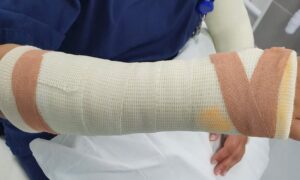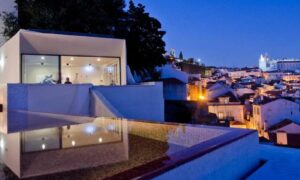(Editor’s note: Our friend, career expat and travel contributor Mike Eggers spent six weeks this summer diving in the South Pacific including Papua New Guinea and Australia. It’s good to be him. Here’s Pt. 1, Papua New Guinea.)
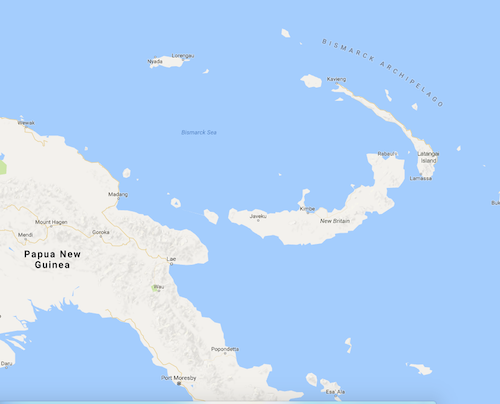 To get to where I wanted to go diving (remote Papua New Guinea) from where I live (Texas) was an adventure in and of itself.
To get to where I wanted to go diving (remote Papua New Guinea) from where I live (Texas) was an adventure in and of itself.
Instead of heading west toward Asia and then taking a sharp right, downward turn to Australia and Papua New Guinea, I needed to head east to Europe. Uh, what?
Oh, and I had to fly four different airlines: United, Lufthansa, Thai Airlines and Singapore Airlines.
So, I flew to Frankfurt, Germany on Lufthansa Airlines; got off the plane; put my dive gear into a storage locker, and took the train to Eindhoven, Netherlands.
There Dispatches Europe co-founder/co-CEO Cheryl Boyd picked me up and we drove to Strijp (pronounced Stripe).
After a brief stay in the Netherlands, it was off to Brisbane, Australia.
BISMARCK SEA AND PAPUA NEW GUINEA
The morning of 11 June, I linked up with African and Oriental Travel Co. owners Raf and Cisca Jah at the Brisbane airport and we checked in and soon were flying to Port Moresby, Papua New Guinea.
There we linked up with Stevie and Diane, the last two members of our group going on this adventure. Once there we grabbed our bags and headed over to the domestic terminal to check in for our flight to Hoskins Airport on West New Britain Island; this is on the southern portion of the Bismarck Sea.
As we approached the airport you could see a number of dormant volcanos poking up; a reminder we are in the Ring of Fire of the Pacific Ocean. Our ride was waiting for us and an hour later we rolled into the Walindi Plantation Resort, our home for the next two days before boarding the MV FeBrina (MV – Motor Vessel; Fe the chemical symbol for iron and Brina, not certain what it stands for).

MV FEBRINA
I got in one dive before we started our live-aboard on the MV FeBrina and dove on the house reef, Hanging Garden.
During the dive I kept noticing rods with different color nylon flags on them and numbers at the base. My dive guide told me that it was part of a long-term research project to study the different species of Anemone Fish (aka Clown Fish or Nemo of “Finding Nemo” fame).

Sure enough I saw at least four different types of Anemone fish at that one dive site and of course took their pictures. That was a nice addition to the dive.
We boarded the boat the next afternoon and met the rest of the passengers: Doug from the USA, who won the dive trip through an underwater photo contest; Mike, Karen and Evan from Canada; and George, an Australian who has been sailing on the FeBrina off and on for almost 20 years.
We also met the crew: Captain Alan, First Mate/Dive Guide Andrew, Trip Director/Dive Guide Josie and seven other crew members.
On the main level is the kitchen and dining area. During our week-long trip this small kitchen put out delicious first class meals, and I’m sure I gained weight.
Each cabin door is a beautiful hand-carved piece of art displaying sea life, flowers, and cultural scenes. So this was going to be my home for the next week.
Our daily schedule started around 0630 (I got up around 0545 to catch the sunrise) with a dive briefing and we tried to be in the water for the first dive around 0700. If you wanted something to eat before, a continental style breakfast was set up. But most of us had breakfast after the first dive. Two more dives would be done before lunch, which was usually around 1300; and a fourth dive around 1500.
Sometimes there would be a fifth dive at night when some really interesting sea creatures come out to play. This was the first time in my diving experience where I did four dives a day and I am happy to report that my body and ears held up OK.
I’m not going to give you a day-by-day description of each of the 20-plus dives I did. Not that they weren’t each different in their own way.
So I’ll give you some highlights and they’re not in any particular order:

• We were wrapping up diving on the Goru Arches when we noticed a body diving through the water near the surface. It wasn’t one of the crew or guests. When we surfaced there were several dugout canoes near our boat. It was some islanders who paddled out to do some trading with the crew; fruits and vegetables from them and personal hygiene items from the boat. Some of us had various snacks that we shared with the kids and women. Though a short interaction, it gave us a little glimpse of local life.

YEAH, THEY’RE THAT CLOSE.
• One of the more exciting dives was the shark feed at Norman’s Knob. This would be an opportunity to get a close view of Silver Tip Sharks. We were “seated”/positioned along the edge of coral ledge overlooking open water. A couple of sharks were coasting back and forth in the “blue” as we got settled.
You could tell they knew what was coming. Andrew started “throwing” out fish heads and other fish parts and the sharks and other fish came in for the free food. There were around six Silver Tip Sharks that swooped in to get a bite.
These sharks are just quite gorgeous to look at. Their shape is geometrically proportioned and their lines flow seamlessly. Yes, I’m describing a shark.
The back edge of their triangular back fin looks like it was dipped in silver; along with the tips of their dorsal fins and tail. These silver markings stand out against their battleship gray bodies. All together this makes them a wonderful sight to behold.
These sharks were fairly comfortable around the divers and didn’t hesitate to swim by you only a foot away. In fact, a couple times they literally bumped their noses against the glass domes that covered some of the cameras other divers were using! I even had one hit my flash extension with its fin.
Was I worried? Not really.
Between being respectful of this predator, not over-reacting, enjoying the interaction, and probably naive ignorance, I wasn’t scared. The feed lasted about 15 minutes, and we swam around the reef until it was time to surface. It was a memorable experience with an amazing sea creature.

A HAWKSBILL IN HOPES OF A MEAL
• Another amazing sea creature we had up close and personal interaction with at Norman’s Knob and later at Jayne’s Gully was the Hawksbill Sea Turtle. They can grow up to almost four feet in diameter and weigh around 150 pounds. So you’ll know they are there if they bump into you.
The ones we met at these two sites were very comfortable swimming with the divers and had no problem getting into your face! If you got a piece of broken coral they would eat it out of your hand. One of these turtles recognizes Josie, our dive director and it glides alongside her as she swims. It even nuzzles her arm to get her to feed it. They were quite fun to watch and gave me many opportunities to take their pictures.
Those were some of the highlights of sailing on the MV FeBrina for a week. The relaxing waters of the Bismarck Sea, seeing the colorful sunrises and sunsets (and the occasional rainbow), the smoking volcanos of the Ring of Fire and the citizens of the water made this another fantastic experience.
One I hope to repeat again.
TUFI BAY
Our next stop was Tufi Resort, Tufi, Oro Province, Papua New Guinea. It is on the other side of the Owen Stanley Range from Port Moresby, along the Solomon Sea.
We flew from New Britain Island to Port Moresby and then from Port Moresby to the Tufi International Airport.
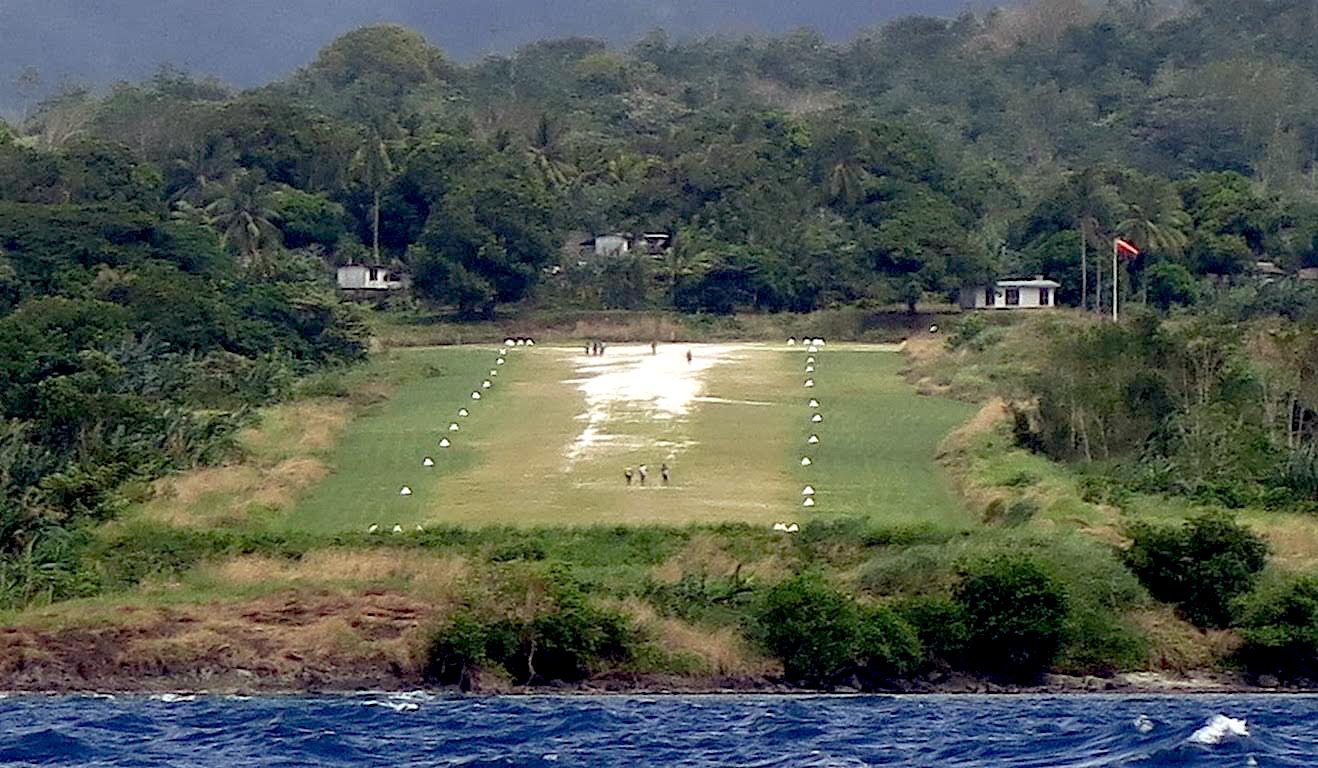
TUFI INTERNATIONAL, WHERE IT’S ALL UPHILL.
Now, this airport is kind of interesting. It’s about 3,000 feet long and made of crushed rock and coral. One end is a treeline and the other end about 100 feet of drop-off ground, coral and the Solomon Sea.
Two engine aircraft are the biggest that can land there. Oh, and the runway runs uphill from the water to the wood line. Quite the landing and later on, take-off experience.
The resort sits on a hill that overlooks Tufi Bay and the Solomon Sea. The bay used to be a WWII PT Boat squadron base and the wreckage of two PT boats lay on the bottom at 35 meters. I didn’t dive on them but a couple friends did and took some neat pictures of them.

NORWAY ISN’T THE ONLY PLACE WITH FJORDS
Because of the lava flow thousands of years ago, this part of PNG has fjords (and you thought Norway had them all.).
They are quite picturesque, but they would impact our diving. More on that later. The resort has been around for 17 years and has a number of bungalows – single story or two-story; a main building with colorful wall murals of sea and island life; cool air tank art by the bar; a pool; and covered deck that also serves as a dining room and overlooks Tufi Bay and a portion of the fjord.

THE SHARKS ARE FRIENDLY, BUT BEWARE OF BIRDS
The resort has a pair of Hornbills that wander the grounds, and the male is a bit territorial and would chase you. ☺
This was the first time for all of us coming to this dive resort. We went down to the harbor dive shop to organize our gear and take in the sights. We stood on the dock and took in the views: the high ridgeline that protects the boats and how quickly boats can enter the Solomon Sea. You could imagine the WWII PT boats starting up their engines, untying their lines, and rumbling out on patrol.
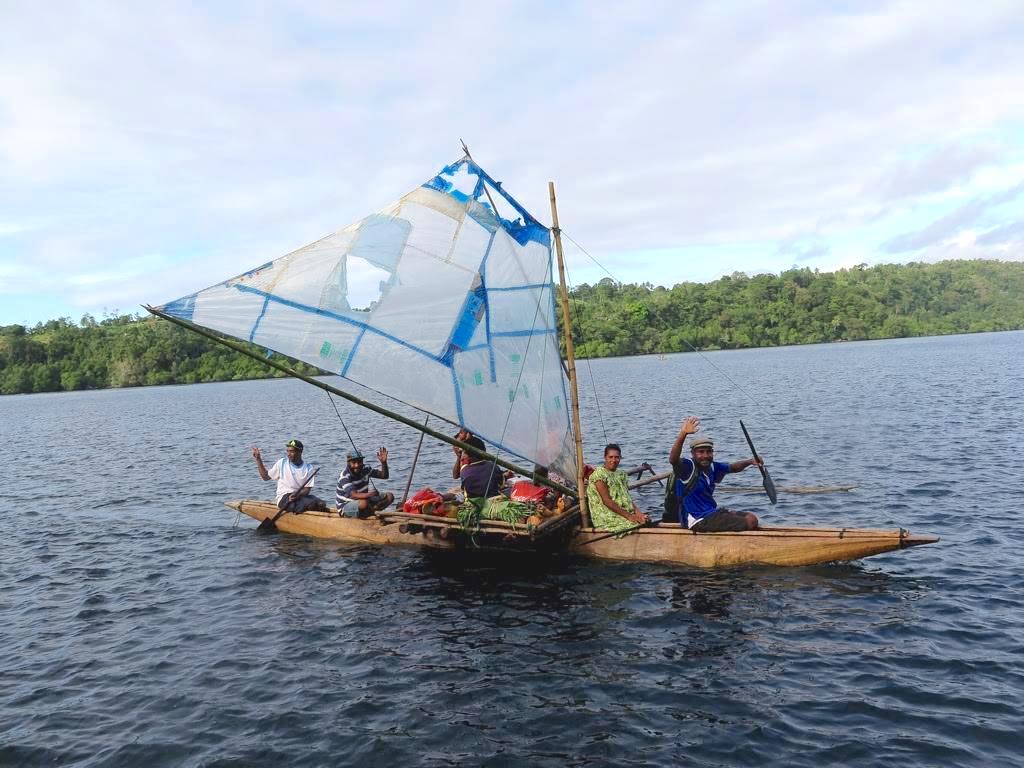
We didn’t have PT boats, but we did have our dive boats and local boats that motored in and out. There were also local canoes/sailing boats that came into the harbor to trade. The sails were often patchwork of plastic connected together with blue strips of tape.
A dive “hiccup” happened our first day. It seems that Mother Nature likes to switch things up in this part of PNG by changing the direction of the trade winds between May and November.
When the trade winds shift this time of year they can create three- to five-foot white capped waves! First, that makes it very difficult to keep the boat on the straight and narrow; second, it can lead to upset tummies; and third, it isn’t safe for all concerned. So, out of the nine possible dives, we did four on the inner reef sites and five others along the coastline and in the fjord.
The inner reef sites were a lot of fun and beautiful, and, supposedly, the outer sites were more spectacular. The sites where we dove along the coastline and in the fjord were very nice and had their own unique beauty and sights we would not have had farther out.
Large Elephant Ear coral (they do resemble an elephant’s, ear slightly curled), the usual variety of Clown Fish, bright red coral, some WWII trash (and unfortunately, newer trash), and numerous other sea life kept us entertained and taking pictures!

On our last night, the resort coordinated a performance of local dances and songs performed by the villagers. They were dressed in handmade traditional clothes of palm frond skirts or tapa loin cloths, flower leis and painted tattoos on their faces. Most of the performers were teenagers or younger, and they gave us a wonderful show.
It was a nice way to finish our visit.
The gang went to Brisbane and beyond, while I traveled to Cairns to extend my diving season. Stay tuned for Part 2 … and more sharks!
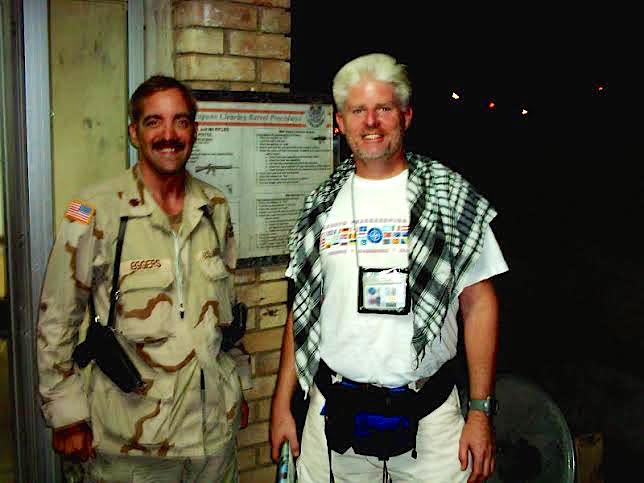
MIKE EGGERS, LEFT, WITH DISPATCHES EUROPE CO-FOUNDER TERRY BOYD IN BAGHDAD CIRCA 2005.
About the author: Mike Eggers might be the best-traveled private citizen in the world. As a U.S. Army officer, Mike lived in Germany, Turkey, South Korea and several other countries.
Now, he’s basically a global citizen, hopping from exotic locale to exotic locale.
To give you some sense of the scale of his peripatetic lifestyle, he visited United Arab Emirates, Oman, Tanzania, Turkey, Singapore, Malaysia and Uzbekistan. In one year … 2016. When he’s not traveling, he splits his time between San Antonio, Texas and Carmel, Calif.
See all of Mike’s travel posts here.



